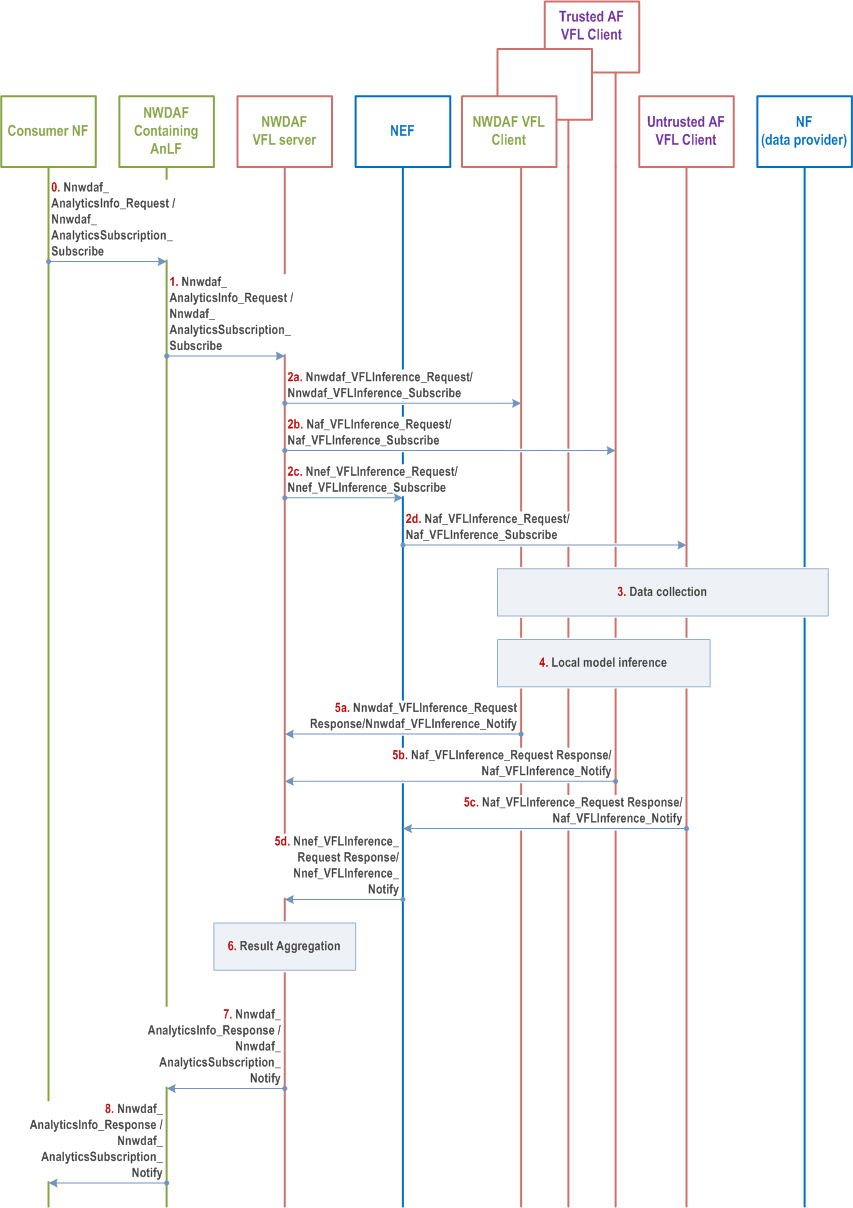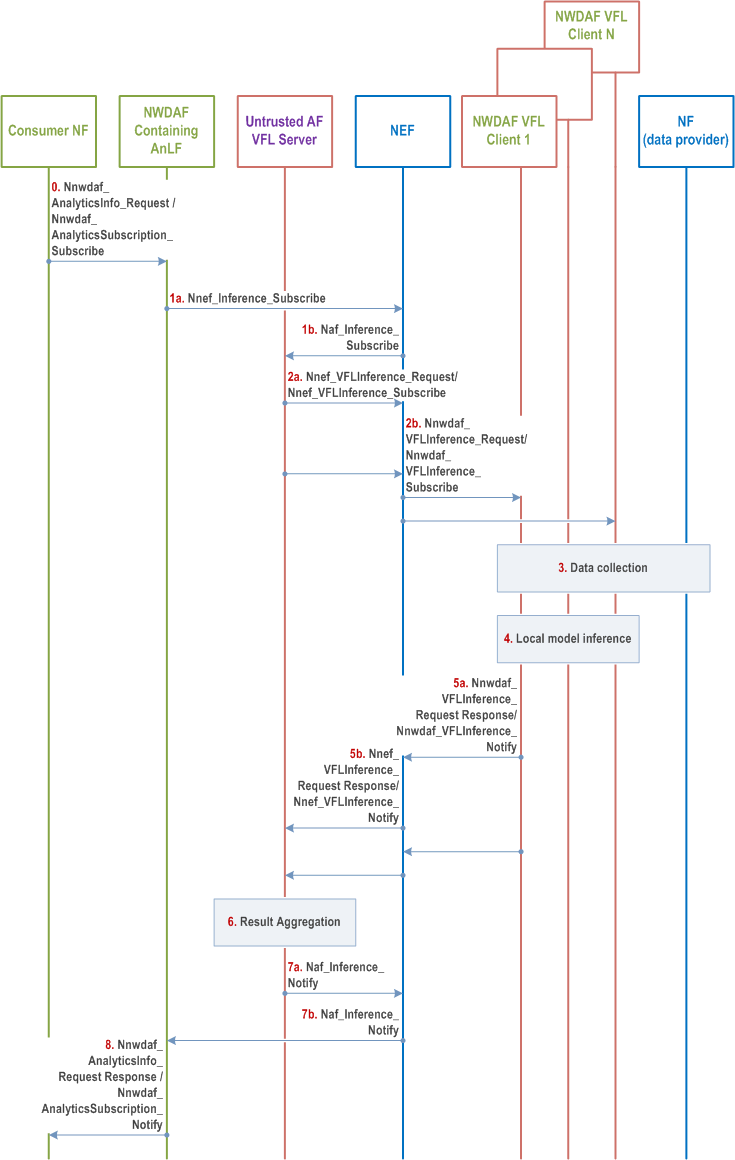Content for TS 23.288 Word version: 19.1.0
1…
4…
5…
5A…
6…
6.1.3
6.1.4…
6.1.4.4…
6.1.5…
6.1A…
6.1B…
6.1B.2.3…
6.1C
6.2…
6.2.3…
6.2.6…
6.2.6.2
6.2.6.3…
6.2.6.3.3
6.2.6.3.4
6.2.6.3.5
6.2.6.3.6…
6.2.7…
6.2.8…
6.2.9…
6.2.13…
6.2A…
6.2B…
6.2B.3
6.2B.4…
6.2C…
6.2D…
6.2E…
6.2F…
6.2H…
6.2H.2.2…
6.2H.2.3…
6.2H.2.4…
6.3…
6.4…
6.5…
6.6…
6.7…
6.7.3…
6.7.4…
6.7.5…
6.8…
6.9…
6.10…
6.11…
6.12…
6.13…
6.14…
6.16…
6.17…
6.18…
6.19…
6.20…
6.21…
6.22…
6.23…
7…
7.4…
7.7…
7.9…
8…
9…
10…
6.2H.2.4 Inference procedure for vertical federated learning
6.2H.2.4.1 Inference procedure for vertical federated learning when NWDAF is acting as VFL server
6.2H.2.4.2 Inference procedure for vertical federated learning when untrusted AF is acting as VFL server
6.2H.3 Contents of ML Model Training service for Vertical Federated Learning
...
...
6.2H.2.4 Inference procedure for vertical federated learning p. 173
6.2H.2.4.1 Inference procedure for vertical federated learning when NWDAF is acting as VFL server p. 173

Step 0.
The analytics consumer NF sends an Analytics request/subscribe (Analytics ID, Target of Analytics Reporting= e.g. UE IDs and optionally Analytics Reporting Information=Analytics target period and Analytics Filter) to NWDAF containing AnLF by invoking a Nnwdaf_AnalyticsInfo_Request or a Nnwdaf_AnalyticsSubscription_Subscribe .
Step 1.
If the NWDAF containing AnLF can be the VFL server to generate the VFL inference results for the requested analytics ID, then step 1 is skipped.
If the NWDAF containing AnLF can not generate the analytics output, the NWDAF containing AnLF determines the VFL Server for the requested analtyics, sends a subscription request to NWDAF VFL server using Nnwdaf_AnalyticsInfo_Request or Nnwdaf_AnalyticsSubscription_Subscribe including Analytics ID, Target of Analytics Reporting = e.g. UE IDs and optionally Analytics Reporting Information=Analytics target period and Analytics Filter.
Step 2.
Based on the information received in the step 0 or 1, VFL server decides to initiate the VFL inference procedure with the VFL clients. VFL Server selects clients(s) using information stored in the VFL training process. The server may select some or no clients, e.g. depending on the accuracy of the VFL model, the contribution to the training result and the current status of the VFL clients.
When no VFL Clients are selected, the VFL server may generates the VFL inference results based only on its local trained ML model associated with the determined VFL correlation ID, skipping the steps 2 - 6 (and 7 if step 1 was also skipped).
VFL server NWDAF sends a VFL Inference request/subscription to the VFL clients including the Target of VFL inference = e.g. UE IDs, VFL correlation ID to indicate the VFL client which previously well-trained VFL local model associated with this ID will be used and optionlly VFL inference filter.
Step 2a.
For each NWDAF VFL client, the VFL Server NWDAF sends an Nnwdaf_VFLInference_Subscribe or Nnwdaf_VFLInference_Request to the VFL client.
Step 2b.
For each trusted AF VFL client, the VFL Server NWDAF sends an Naf_VFLInference_Subscribe or Naf_VFLInference_Request to the VFL client.
Step 2c.
For each untrusted AF VFL client, the VFL Server NWDAF sends an Nnef_VFLInference_Subscribe or Nnef_VFLInference_Request to the NEF serving the AF.
Step 2d.
For each untrusted AF VFL client, the NEF converts any internal identifiers to external identifiers and sends an Naf_VFLInference_Subscribe or Naf_VFLInference_Request to the untrusted AF VFL client.
Step 3.
Each VFL Client collects its local data by using the current mechanism if the VFL Client does not have local data available already.
Step 4.
Based on the VFL correlation ID, each VFL Client determines the VFL local model to generate the intermediate local inference results.
Step 5.
VFL Client sends the client intermediate results to the VFL server.
The intermediate results, which are sent from the VFL Client to the VFL Server during the VFL inference process, are the information for the VFL Server to combine and generate the VFL inference results.
If the VFL server used an inference subscription in step 2, step 5 may be repeated.
Step 5a.
Each NWDAF VFL client sends an Nnwdaf_VFLInference_Notify or Nnwdaf_VFLInference_Request response to the VFL Server NWDAF.
Step 5b.
Each trusted AF VFL client sends a Naf_VFLInference_Notify or Naf_VFLInference_Request response to the VFL Server NWDAF.
Step 5c.
Each untrusted AF VFL client sends a Naf_VFLInference_Notify or Naf_VFLInference_Request response to the NEF.
Step 5d.
For each untrusted AF VFL client, the NEF converts any external to internal identifiers and sends an Nnef_VFLInference_Notify or Nnef_VFLInference_Request response to the NWDAF VFL server.
Step 6.
The VFL server may collect its local data and generate the intermediate local inference results. When the VFL Server selected VFL clients to participate in the VFL Inference process, it combines all the intermediate results to generate the VFL inference results based on the VFL correlation ID. The VFL server takes into account the participation of each VFL client during the ML training process and the importance of the intermediate results when generates the combined inference output.
Step 7.
Depending on request, the NWDAF VFL server sends Nnwdaf_AnalyticsInfo_Response or Nnwdaf_AnalyticsSubscription_Notify to the consumer (i.e NWDAF containing AnLF) including the VFL inference results.
Step 8.
The NWDAF containing AnLF provides the analytics output to the analytics consumer NF based on the VFL inference results by means of either Nnwdaf_AnalyticsInfo_Response or Nnwdaf_AnalyticsSubscription_Notify , depending on the service used in step 0.
6.2H.2.4.2 Inference procedure for vertical federated learning when untrusted AF is acting as VFL server p. 176

The inference procedure when untrusted AF is acting as VFL server may be triggered by a request or subscription from a 5GC consumer NF or internal service logic of the AF acting as VFL server. If triggerd by internal service logic of the AF acting as VFL server, the steps 0, 1,7 and 8 are skipped. The inference procedure triggerd by internal service logic of the AF acting as VFL server is out of 3GPP scope.
Step 0.
Same as step 0 in clause 6.2H.2.4.1.
Step 1.
Same as step 1 in clause 6.2H.2.4.1, to NEF using Nnef_Inference_subscribe . NEF forwards the subscription request to AF using Naf_Inference_subscribe .
Step 2.
Same as step 2 in clause 6.2H.2.4.1, to NEF using Nnef_VFLInference_subscribe . An untrusted AF includes the external NWDAF ID and sends the request to the NEF.
NEF converts any received external identifiers to internal identifiers and forwards the subscription request to NWDAF using Nnwdaf_VFLInference_subscribe .
Step 3.
Same as step 3 in clause 6.2H.2.4.1.
Step 4.
Same as step 4 in clause 6.2H.2.4.1.
Step 5.
Same as step 5 in clause 6.2H.2.4.1, to NEF using Nnwdaf_VFLInference_Notify .
NEF converts any received internal identifiers to external identifiers and forwards the subscription notify to the untrusted AF using Nnef_VFLInference_Notify .
If the VFL server used an inference subscription in step 2, step 5 may be repeated.
Step 6.
Same as step 6 in clause 6.2H.2.4.1.
Step 7.
Same as step 7 in clause 6.2H.2.4.1, to NEF using Naf_Inference_Notify .
NEF converts any received internal identifiers to external identifiers and forwards the subscription Notify to NWDAF using Nnef_Inference_Notify .
Step 8.
Same as step 8 in clause 6.2H.2.4.1.
6.2H.3 Contents of ML Model Training service for Vertical Federated Learning p. 177
The consumers of the ML Model training services may provide the input parameters in Nnwdaf_VFLTraining service or Naf_VFLTraining service or in Nnefe_VFLTraining service as listed below:
- Analytics ID: identifies the analytics for which the ML Model is requested to be trained.
- VFL Interoperability Information that indicates the intermediate results that the VFL Server supports (e.g. activation function, gradients, type of loss), the content of the VFL Interoperability Information is not standardized in this release.
- The list of samples selected by Server.
- VFL Interoperability information supported by each VFL Clients.
- The list of samples selected by VFL client.
- The Feature ID(s) that the VFL client supports. A Feature ID indicates that what features the VFL client can use for an Analytics ID, the values of the Feature ID are not standardized.